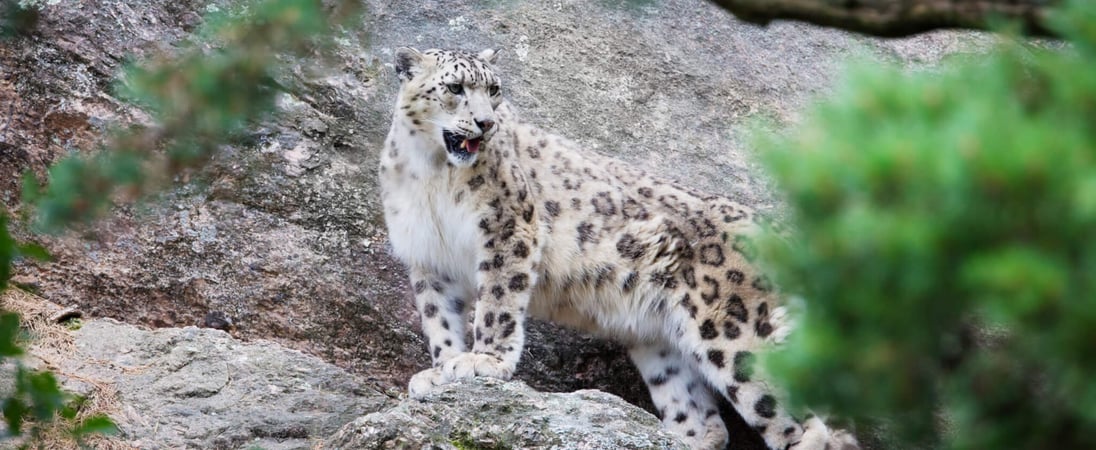
International Snow Leopard Day
These majestic creatures prowl the mountains with grace and power, their stunning coats blending seamlessly into the snowy landscape.
Snow Leopards are captivating and powerful animals. However, they are also vulnerable to loss of prey and poaching.
These animals are distributed sparsely across 12 different countries in Central Asia. They tend to be found in rugged, high mountain landscapes, at elevations between 3,000 and 4,500m.
The key to protecting this species is raising awareness. That’s what International Snow Leopard Day is all about.
How To Observe International Snow Leopard Day
There are a number of different ways that you can support International Snow Leopard Day. So, here are some suggestions…
Learn and explore – One of the best ways to observe International Snow Leopard Day is to learn about this incredible creature. Spend some time reading up on the snow leopard. Find out about where the animal lives, what threats they face, and what steps we can take in order to help safeguard the future of this incredible animal.
Get creative – Another way to show your support is to get creative. There are some activities online involving the snow leopard. You can find a fun activity sheet via the WWF website.
Order a WWF Explore Badge – Another way to show your support for International Snow Leopard Day is to order a WWF Badge. This is something else that you can get on the WWF website.
Adopt a snow leopard – You can also support snow leopards by adopting one. This helps the WWF to monitor snow leopard movements, by giving local communities the support needed to do this, as well as reducing human snow leopard conflicts.
Fundraise – You may also decide to host a fundraising event. This is a great way to raise awareness about the problems that snow leopards face while also accumulating donations that can go towards helping them.
There are so many different ways that you can fundraise. You may decide to host a fundraising event, such as a cook-off, bake sale, or fun run. Another option is to make products that you can sell and then you could donate the proceeds or a percentage of them to helping snow leopards.
History Of International Snow Leopard Day
The first International Snow Leopard Day occurred on the 23rd of October in 2014. The main purpose of this day is to show the importance of snow leopard conservation and raise awareness about this incredible animal.
The day also emphasizes the importance of taking measures to stop poaching, as well as consolidating efforts in terms of an environmental organization in the countries of the snow leopard range.
The day was initiated by the countries that encompass the snow leopard’s range. They include Uzbekistan, Tajikistan, Russia, Pakistan, Mongolia, Kyrgyzstan, Kazakhstan, India, China, Bhutan, and Afganistan.
On the 23rd of October, in 2013, these countries signed the Bishkek Declaration regarding the conservation of the snow leopard. This happened in the capital of Kyrgyzstan, Bishkek, at the very first Global Snow Leopard Forum.
Fascinating Facts About Snow Leopards
- Snow leopards are able to prey on animals that are up to three times their own body weight.
- They have massive, thick tails, which are able to help them maintain balance and shield them from harsh weather. Their tails are almost as long as their entire body.
- A study from the WWF has recorded snow leopards living at 5,859 meters above sea level. This is the highest altitude that has ever been documented for big cats. This is about the same height as the highest mountain in Canada.
- You may be surprised to learn that snow leopards are not able to roar. Instead, they mew, yowl, and growl. They also prusten, which is also known as chuffing. This is a non-threatening vocalization, which is made when they blow air through their nose.
- The fur on the stomach of a snow leopard is almost five inches thick. This is so that they can survive in the harsh and cold mountain climates.
- These animals are often referred to as ‘ghosts of the mountain’ because they spend most of their lives in solitude and they are rarely seen.
- Snow leopards are the only big cats that call Asia’s cold deserts their home. These deserts are sometimes referred to as the third pole because they feature ice fields with the biggest reserves of freshwater outside of the southern and northern polar regions.
What Threats Do Snow Leopards Face?
The exact number of snow leopards is unknown. Experts believe that there is no more than 6,390 snow leopards around the world, yet the number could be as small as 3,920.
There are a number of threats that this elusive cat faces, including poaching. Data is hard to come by in this respect because a lot of trades with snow leopard parts occur in the dark.
Some research shows that one snow leopard has been killed and traded every day between 2008 and 2016. However, the true extent of the issue is thought to be even bigger.
No animal should be poached, and this is why the likes of International Snow Leopard Day are so important so that we can raise awareness about the issue. Poaching is also a problem because it takes away resources for the snow leopard.
The main prey species for the snow leopard are wild goat and sheep. However, these species are also threatened by unsustainable or illegal hunting in a lot of the parts of the snow leopard range. So, if there is a decline in their populations, there is also going to be a decline in the population of the snow leopard.
Snow leopards face a number of other threats that a lot of people don’t consider. For example, their mountain ecosystem could be destroyed because of large-scale developments, including mining. Climate change also poses a number of challenges as well.
Temperatures are increasing in the mountains across Central Asia. This has an impact on the entire ecosystem; from water supplies to vegetation.
It is certainly worrying times for snow leopards, and a good way to spend International Snow Leopard Day is by educating yourself fully on the issues these animals face.
International Snow Leopard Day FAQs
How do snow leopards feature in traditional Himalayan folklore?
In Himalayan folklore, snow leopards are often depicted as mystical creatures.
Some tales portray them as protectors of the mountains, embodying spiritual significance and serving as symbols of purity and balance in nature.
What unique physical adaptations help snow leopards survive in high-altitude environments?
Snow leopards have evolved several adaptations for mountainous terrains.
Their wide, fur-covered paws act as natural snowshoes, distributing their weight to prevent sinking into snow.
Additionally, their long, thick tails aid in balance and can wrap around their bodies for warmth during cold periods.
How do local communities in snow leopard habitats contribute to conservation efforts?
In regions like Dolpa, Nepal, local communities play a crucial role in snow leopard conservation.
They engage in community-based initiatives that combine traditional knowledge with modern technology to monitor snow leopard populations and mitigate human-wildlife conflicts.
These collaborative efforts have led to increased awareness and proactive measures to protect snow leopards.
Are there any modern cultural representations of snow leopards?
Yes, snow leopards have been featured in modern media.
For instance, the 2024 film “Snow Leopard” by director Pema Tseden explores the complex relationship between humans and snow leopards in Tibet, highlighting cultural and ethical dilemmas.
How has climate change impacted snow leopard populations and their habitats?
Climate change has led to rising temperatures in mountainous regions, causing habitat loss and shifts in prey availability for snow leopards.
Melting glaciers and altered precipitation patterns affect the delicate balance of these ecosystems, posing challenges to snow leopard survival.
What are some unique ways countries celebrate International Snow Leopard Day?
In Kyrgyzstan, the birthplace of the Bishkek Declaration, International Snow Leopard Day is marked by educational programs, art exhibitions, and community events focused on conservation.
Similarly, Nepal hosts awareness campaigns and workshops involving local communities to promote coexistence with snow leopards.
How do snow leopards communicate if they cannot roar like other big cats?
Unlike other big cats, snow leopards cannot roar due to the physiology of their vocal cords.
Instead, they communicate using a variety of sounds, including mews, growls, and a unique non-threatening vocalization known as ‘chuffing.’ This repertoire allows them to convey messages without the need for roaring.
What are some misconceptions about snow leopards’ behavior and habitat?
A common misconception is that snow leopards inhabit only snowy regions. In reality, they are found in diverse habitats, including arid and rocky areas at high altitudes.
Another myth is that they are aggressive towards humans; however, snow leopards are known for their elusive nature and tend to avoid human interaction.
Are there any notable art forms inspired by snow leopards in various cultures?
Snow leopards have been a source of inspiration in Tibetan art for centuries.
They are commonly featured in traditional Thangka paintings, symbolizing power and protection.
These artworks serve both religious and cultural purposes, reflecting the reverence of snow leopards in Tibetan society.
How can individuals contribute to snow leopard conservation efforts?
Individuals can support snow leopard conservation by participating in awareness campaigns, donating to reputable wildlife organizations, and advocating for policies that protect their habitats.
Engaging in eco-friendly practices and supporting sustainable community initiatives in snow leopard regions also contribute to their preservation.
Also on ...
View all holidaysNational Mole Day
In the world of atoms, there's a magical number that gives substance to chemistry's dance – a secret ingredient to understanding matter's recipe.
National Boston Cream Pie Day
A delightful dessert with layers of sponge cake, velvety cream, and a luscious glaze, it's a sweet symphony of flavors and textures.
We think you may also like...
National Dress Up Your Pet Day
Set up a literal catwalk and treat your furry friends to some safe, comfortable fashion, organize a fun photo shoot or go all out with matching outfits.
National Cat Herders Day
From project managers to parents, show appreciation for people in your life who achieve seemingly impossible tasks with patience and humility.








